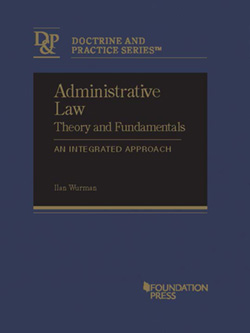A New Casebook: Administrative Law Theory and Fundamentals: An Integrated Approach, by Ilan Wurman

New casebooks can be hard to justify, so I thought I would say a few words about my new casebook, Administrative Law Theory and Fundamentals: An Integrated Approach, recently out with Foundation Press’s new Doctrine & Practice Series. It seems to me that, particularly in view of a more originalist Supreme Court, administrative law is in some need of fresh thinking. In City of Arlington v. FCC, 569 U.S. 290 (2013), Chief Justice Roberts described the administrative state as unlawfully combining legislative, executive, and judicial powers. “Although modern administrative agencies fit most comfortably within the Executive Branch,” he wrote, “as a practical matter they exercise legislative power, by promulgating regulations with the force of law; executive power, by policing compliance with those regulations; and judicial power, by adjudicating enforcement actions and imposing sanctions on those found to have violated their rules. The accumulation of these powers in the same hands,” Roberts added, “is not an occasional or isolated exception to the constitutional plan; it is a central feature of modern American government.”
Roberts’ description is standard fare in conservative and originalist circles, but is it accurate? My new casebook proposes a theory of administrative power that is a bit different, and that better explains constitutional text and structure as well as historical and modern practice. The casebook argues that there are “exclusive” powers that only Congress, the President, and the courts can respectively exercise, but also “nonexclusive” powers that can be exercised by more than one branch. Not every regulation is an exercise of the legislative power that Congress must exclusively exercise. Some regulations are nonexclusive in the sense that they can be exercised by both branches and therefore partake in both legislative and executive qualities. Not every adjudication is an exercise of the judicial power that courts must exclusively exercise; many are in fact over “public rights” that can be adjudicated in any of the three branches. Call it “nonexclusive judicial power,” if you will.
This theory of nonexclusive powers explains many administrative law concepts and debates better than competing accounts. It explains what Chief Justice Marshall meant when he wrote in Wayman v. Southard that Congress cannot delegate power that is “exclusively legislative” in nature, but it can delegate to other departments power that it could have exercised itself, namely, the power to fill in the details pursuant to a more general provision. In other words, there comes a point where Congress could continue legislating, but it doesn’t have to—it can leave the details to the Executive. One of the earliest examples is the statute providing for the pension payments to the invalid veterans of the revolutionary war “under such regulations as the President of the United States may direct.” President Washington and his Secretary of War, Henry Knox, promulgated regulations respecting the timing of the payments—two equal payments three months apart—and the affidavits and proofs that would be required of the individuals claiming entitlement to the pension. Could Congress have enacted these regulations in a statute? Of course. But did it have to do so? No. It was sufficiently a matter of detail that it could be left to the Executive. The regulations partook in both legislative and executive qualities and could have been promulgated by either branch. I call it nonexclusive legislative power. But these regulations didn’t have to be promulgated by Congress—they weren’t exercises of exclusively legislative power.
The distinction between exclusive and non-exclusive powers also explains why the concept of “quasi-legislative” and “quasi-judicial” power is appealing but ultimately erroneous. The concept is appealing because a regulation can look legislative, and an adjudication can look judicial. And that is because most regulations created by the Executive could be done by Congress, and an adjudication over public rights, for instance, can be assigned to the courts. But neither has to be. Quasi-powers are misleading, however, because the Court in Humphrey’s Executor suggested that these are powers that need not be exercised by any of the branches. Nonexclusive powers helps us to clarify that such power can often be exercised by more than one branch, but such power still has to be exercised by at least one of the constitutional branches of government.
The distinction between exclusive and nonexclusive powers also explains the “chameleon-like” quality of government power, which Justice Stevens often observed. He proposed in a few cases that we should frankly recognize that when the Executive engages in rulemaking, it is exercising legislative power. The concept of nonexclusive powers shows why that’s wrong, at least some of the time, as in the case of George Washington’s regulations. I think this theory also explains why Congress must authorize agencies to promulgate “legislative rules,” which are nonexclusive legislative power, but not interpretative rules or policy statements, which are executive power simply. The theory also better explains Chevron deference, once it is acknowledged that in most Chevron cases agencies are not actually interpreting law, but rather making policy—that is, exercising nonexclusive legislative power. And the theory explains why many, though certainly not all, administrative adjudications are probably constitutional.
To sum up and conclude, administrative law is in need of a serious rethinking and clarification—and my new casebook lays the necessary groundwork. It takes formalism and originalism seriously, but concludes that much, although not all, of the administrative state may be constitutional after all. So that you can read more about the casebook, I have posted a five-page essay to SSRN that spells out the arguments I’ve made in this post in a bit more detail. And of course you can request an examination copy here.
Ilan Wurman is an Associate Professor of Law at the Arizona State University’s Sandra Day O’Connor College of Law.



